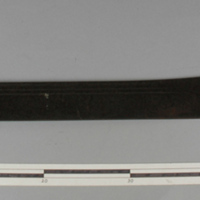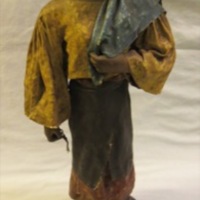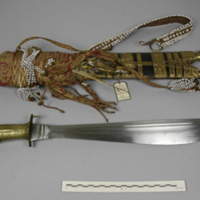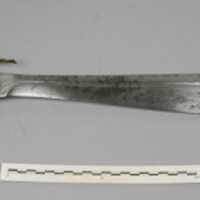Tausug/Moro chain mail armour shirt
Text
Chain mail armour shirt with plates. [El.B 28/3/2007]
Share this
Media
Images
Map Pitt Rivers Museum
Metadata
Subject
Armour shirt
Date
Date made: 1893
Type
Armour
Identifier
1940.8.2.1
Origin
Moro Gulf, Mindanao, Philippines (Tausug/Moro)
Materials
Iron, silver
Provenance
Mabel How.
Field collector: R. Hugh Chapman. Collected 1893.
Field collector: R. Hugh Chapman. Collected 1893.
Acquisition Date
1940
Short description
The following notes are drawn from research compiled by Andy Mills as part of the DCF Cutting Edge project in 2006-2007. This metallic armour has quite a different cultural ancestry from the everyday armour of the Moro of Mindanao island which is much the same as that form Borneo and the Naga Hills (conical caps and barkcloth or leather jackets). This armour bears much similarity to the Islamic mail-and-plates armour around it, and it has its antecedents in armour imported by Muslims, who have been doing business, and conducting missionary work, in the Philippines since the 10th century AD. Usually, Moro armours of this kind are of brass mail and brass plates (as here), or brass mail and plates of the horn of the Carabao – a Filipino subspecies of the Water Buffalo (Bubalus bubalus). The armour opens shirt-like down the front, as with most Islamic armours, but has the added beautification of particularly ornate swivelling hook-and-eye clasps. The scrollwork on these clasps reflects some influence of Indonesian or Bornean origin. This armour was collected in 1893, in Sabah (North Borneo), and reflects a close relationship between the southern Philippines and northern Borneo – facilitated by the voyaging corridor along the islands of Basilan, Sulu and Tawi-Tawi.
Display status
Not on display
Official Website
Collection
Cite this Page
“Tausug/Moro chain mail armour shirt,” Mapping Philippine Material Culture, accessed April 26, 2024, https://philippinestudies.uk/mapping/items/show/27827.
Subjects
Geolocation
Sensitive Content
Mapping Philippine Material Culture collates digital material from institutions, and some of this material is inherently colonial and contains words, terms and phrases that are inaccurate, derogatory and harmful towards Filipino and Filipino diasporic communities. Catalogue transcriptions, book titles, exhibition titles and museum titles may contain harmful terms. We recognise the potential for the material to cause physical and mental distress as well as evoke strong emotions. Owing to the scale of the collection’s data, a process to implement sensitive-content warnings in the displayed data is still incomplete. The material within the catalogue does not represent Mapping Philippine Material Culture’s views. Mapping Philippine Material Culture maintains a strong anti-colonial, anti-racist position and affirms its support for centring the humanity of historically marginalised and disenfranchised communities.
Facebook Twitter



